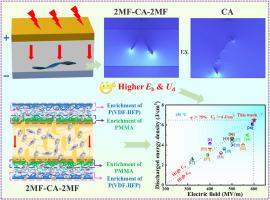Enhancing the high-temperature energy storage performance of sandwich-structured cellulose acetate composite films via multi-scale breakdown-resistant gradient distribution structure
IF 14.2
1区 材料科学
Q1 ENGINEERING, MULTIDISCIPLINARY
引用次数: 0
Abstract
The ability to store energy at high temperature is essential for polymer dielectric films operating in harsh environments. However, the energy storage performance of dielectrics degrades sharply at elevated temperature because of increased leakage current. Here, a facile strategy was reported to address this issue by designing sandwich-structured composite films with multi-scale breakdown-resistant gradient distribution structure. Specifically, cellulose acetate (CA) was served as the intermediate layer, while a poly (methyl methacrylate)/poly (vinylidene fluoride-hexafluoropropylene) (PMMA/(P(VDF-HFP)) (MF) blend was functioned as the creation of the breakdown-resistant outer layers. The hydrogen bonding interaction between layers promotes the redistribution of PMMA molecular chains in outer layers, forming the sublayers enriched in P(VDF-HFP) and PMMA, respectively. The outer layers construct energy barriers to restrict charge injection, while the interfaces between layers are responsible for the creation of deep traps to capture mobile charges and suppress conduction loss. These effects collectively decrease the leakage current, enabling the 2MF-CA-2MF to achieve the discharge energy density () of 6.48 J/cm3 (307 % of pure CA) and the high charge-discharge efficiency () of 76.78 % at 600 MV/m and 150 °C. This work demonstrates that CA-based dielectric films can be a viable candidate for high-temperature energy storage in next-generation power electronics.

通过多尺度抗击穿梯度分布结构提高夹层结构醋酸纤维素复合膜的高温储能性能
在高温下储存能量的能力对于在恶劣环境下工作的聚合物介电薄膜是必不可少的。然而,由于泄漏电流的增加,电介质的储能性能在高温下急剧下降。本文通过设计具有多尺度抗击穿梯度分布结构的三明治结构复合膜来解决这一问题。具体来说,醋酸纤维素(CA)被用作中间层,而聚(甲基丙烯酸甲酯)/聚(偏氟乙烯-六氟丙烯)(PMMA/(P(VDF-HFP)) (MF)共混物被用作抗击穿外层。层间的氢键相互作用促进了PMMA分子链在外层的重新分布,形成了分别富含P(VDF-HFP)和PMMA的亚层。外层构建能量屏障以限制电荷注入,而层与层之间的界面负责创建深阱以捕获移动电荷并抑制传导损失。这些影响共同降低了泄漏电流,使2MF-CA-2MF在600 MV/m和150℃下的放电能量密度(Ud)达到6.48 J/cm3(纯CA的307%),充放电效率(η)达到76.78%。这项工作表明,基于ca的介电薄膜可以成为下一代电力电子中高温储能的可行候选材料。
本文章由计算机程序翻译,如有差异,请以英文原文为准。
求助全文
约1分钟内获得全文
求助全文
来源期刊

Composites Part B: Engineering
工程技术-材料科学:复合
CiteScore
24.40
自引率
11.50%
发文量
784
审稿时长
21 days
期刊介绍:
Composites Part B: Engineering is a journal that publishes impactful research of high quality on composite materials. This research is supported by fundamental mechanics and materials science and engineering approaches. The targeted research can cover a wide range of length scales, ranging from nano to micro and meso, and even to the full product and structure level. The journal specifically focuses on engineering applications that involve high performance composites. These applications can range from low volume and high cost to high volume and low cost composite development.
The main goal of the journal is to provide a platform for the prompt publication of original and high quality research. The emphasis is on design, development, modeling, validation, and manufacturing of engineering details and concepts. The journal welcomes both basic research papers and proposals for review articles. Authors are encouraged to address challenges across various application areas. These areas include, but are not limited to, aerospace, automotive, and other surface transportation. The journal also covers energy-related applications, with a focus on renewable energy. Other application areas include infrastructure, off-shore and maritime projects, health care technology, and recreational products.
 求助内容:
求助内容: 应助结果提醒方式:
应助结果提醒方式:


